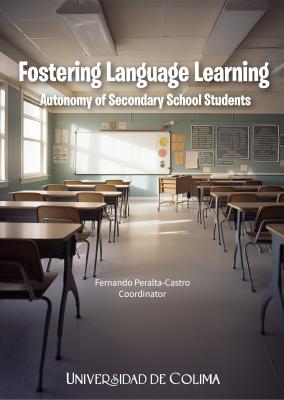Fostering Language Learning : Autonomy of Secondary School Students
Palabras clave:
Instrucción Media en Inglés, Diseño curricular, Estrategias de enseñanzaSinopsis
Este libro surge como resultado de una investigación convocada por la Universidad de Colima para propuestas de profesores investigadores de tiempo completo en 2022 a través de la CGIC (Dirección General de Investigación Científica). La convocatoria fue dirigida a promover la investigación, el avance tecnológico, y la innovación que se dedica a abordar temas de interés nacional, la sostenibilidad estatal, y a mejorar las condiciones de la población de Colima. Este estudio busca evaluar el éxito de un curso de idiomas para mejorar la competencia en el inglés del estudiantado, evaluar el nivel de autonomía desarrollada por estudiantes del inglés como segunda lengua en un curso de cuarenta horas e investigar la importancia de los medios de aprendizaje autónomos.
Descargas
Referencias
Abdelrazeq, A. (2018). Autonomous Learning Levels of Students Majoring in EFL and the Role of their Teachers in Developing Autonomous Learning. Journal of Educational and Psychological Studies [JEPS], 12(4), 724. https://doi.org/10.24200/jeps.vol12iss4pp724-738
Alamer, A., Al Khateeb, A., & Jeno, L. M. (2023). Using WhatsApp scp> increases language students' self motivation and achie- vement, and decreases learning anxiety: A self determination theory approach. Journal of Computer Assisted Learning, 39(2), 417-431. https://doi.org/10.1111/jcal.12753
Allwright, R. L. (1988). Autonomy and individualization in whole-class instruction. In A. Brookes & P. Grundy (Eds.), Individualization and Autonomy in Language Learning. ELT Documents, 131 (pp. 35- 44.). Modern English Publications and the British Council.
Alqarni, N. (2023). Language learning strategies and learning engage- ment as predictors of language learning achievement: an inves- tigation of Saudi EFL learners. Saudi Journal of Language Studies, 3(3), 129-143. https://doi.org/10.1108/SJLS-12-2022-0084
Alrabai, F. (2021). The Influence of Autonomy-Supportive Teaching on EFL Students' Classroom Autonomy: An Experimental Inter- vention. Frontiers in Psychology, 12. https://doi.org/10.3389/fpsyg.2021.728657
Arnold, J., & Fonseca, M. C. (2004). Multiple intelligence theory and fo- reign language learning: A brain-based perspective. International Journal of English Studies, 4(1), 119-136.
Azarnoosh, M., Zeraatpishe, M., Faravani, A., & Reza Kargozari, H. (2016). Issues in Materials Development. Sense Publishers. https://doi.org/10.1007/978-94-6300-432-9
Ba , G. (2016). The effect of multiple intelligences theory-based education on academic achievement: A meta-analytic review. Kuram ve Uy- gulamada Egitim Bilimleri, 16(6), 1833-1864.
Benson, P. (2007a). Autonomy and Its Role in Learning. In International Handbook of English Language Teaching (pp. 733-745). Springer US. https://doi.org/10.1007/978-0-387-46301-8_48
Benson, P. (2007b). Autonomy in language teaching and learning. Language Teaching, 40(1), 21-40. https://doi.org/10.1017/S0261444806003958
Benson, P. (2007c). Autonomy in language teaching and learning. Language Teaching, 40(1), 21-40. https://doi.org/10.1017/S0261444806003958
Benson, P. (2011). Teaching and researching autonomy in language lear- ning (2nd ed.). Pearson Education. https://doi.org/10.1017/S0261444806003958
Benson, P. (2013). Teaching and Researching: Autonomy in Language Lear- ning. Routledge. https://doi.org/10.4324/9781315833767
Benson, P., & Voller, P. (1997). Introduction: autonomy and independen- ce in language learning. In P. Benson & P. Voller (Eds.), Autonomy and Independence in Language Learning (pp. 164-175). Addison Wesley Longman.
Black, A. E., & Deci, E. L. (2000). The effects of instructors' autonomy support and students' autonomous motivation on learning orga- nic chemistry: A self-determination theory perspective. Science Education, 84(6), 740-756. https://doi.org/10.1002/1098-237X(200011)84:6<740::AID-SCE4>3.0.CO;2-3
Candy, P. (1991). Self-direction for lifelong learning: a comprehensive guide to theory and practice. Jossey-Bass.
Carreira, J. M., Ozaki, K., & Maeda, T. (2013). Motivational model of English learning among elementary school students in Japan. Sys- tem, 41(3), 706-719. https://doi.org/10.1016/j.system.2013.07.017
Caruth, G., & Caruth, D. (2013). Understanding resistance to change: a challenge for universities. Turkish Online Journal of Distance Edu- cation, 14(2), 12-21. https://dergipark.org.tr/en/pub/tojde/issue/16896/176041
Castelli, L., Ragazzi, S., & Cattaneo, A. (2014). Mixed Methods for Re- search in Education; a Cross-level Study on Education Systems. Procedia - Social and Behavioral Sciences, 112, 1207-1216. https://doi.org/10.1016/j.sbspro.2014.01.1285
Charmaz, K. (2014). Constructing grounded theory. Sage.
Chinpakdee, M. (2020). Developing Learner Autonomy in Language Lear- ning: A Study in the Thai EFL Secondary School Context [Doctoral thesis]. New Zealand: Victoria University of Wellington..
Corbin, J, & Strauss, A. (2015). Basics of Qualitative Research. Sage.
Cotterall, S. (1995). Developing a course strategy for learner autonomy. ELT Journal, 49(3), 219-227. https://doi.org/10.1093/elt/49.3.219
Creswell, J. W. (2013). Research Design: Qualitative, Quantitative, and Mixed Methods Approaches (4th ed.). SAGE Publications.
Creswell, J. W. (2014). Research Design: Qualitative, Quantitative and Mixed Methods Approaches. Sage.
Creswell, J. W., & Poth, C. N. (2018). Qualitative inquiry and research design: Choosing among five approaches (4th ed.). Sage.
Dang, T., & Chi, H. (2012). Learner autonomy: A synthesis of theory and prac- tice. The Internet Journal of Language, Culture, and Society, 35.
David, L. (1991). Learner autonomy: Definitions, issues and problems. Authentic Language Learning Resources Ltd.
Deci, E. L. (1971). Effects of externally mediated rewards on intrinsic moti- vation. Journal of Personality and Social Psychology, 18(1), 105-115. https://doi.org/10.1037/h0030644
Deci, E. L., Koestner, R., & Ryan, R. M. (2001). Extrinsic Rewards and Intrinsic Motivation in Education: Reconsidered Once Again. Review of Educatio- nal Research, 71(1), 1-27. https://doi.org/10.3102/00346543071001001
Deci, E. L., & Ryan, R. M. (1985). Causality Orientations Theory. In Intrin- sic Motivation and Self-Determination in Human Behavior (pp. 149-175). Springer US. https://doi.org/10.1007/978-1-4899-2271-7_6
Denzin, N. K., & Lincoln, Y. S. (2011). The SAGE handbook of qualitative research (N. K. Denzin & Y. S. Lincoln, Eds.
4th ed.) [Book]. SAGE. Derakhshan, A., & Faribi, M. (2015). Multiple Intelligences: Language Lear- ning and Teaching. International Journal of English Linguistics, 5(4). https://doi.org/10.5539/ijel.v5n4p63
Deregõzü, A. (2014). Development of a scale for the measurement of autono- mous learning. Pakistan Journal of Statistics, 30(6), 1187-1196.
Dickinson, L. (1987). Self-instruction language learning. Cambridge University Press.
Ellis, R. (1994). The study of second language acquisition. Oxford University Press.
Gardner, H. (1987). The theory of multiple intelligences. Annals of Dyslexia, 37, 19-37. http://www.jstor.org/stable/23769277 https://doi.org/10.1007/BF02648057
Gardner, H. (1999). Intelligences reframed: Multiple intelligences for the 21st cen- tury. Basic Books.
Genç, G. (2015). AUTONOMOUS LEARNING CAPACITY OF EFL STUDENT TEACHERS. International Journal of Languages' Education, 1(Volume 6), 23-23. https://doi.org/10.18298/ijlet.483
Gholami, H. (2016). Self Assessment and Learner Autonomy. Theory and Prac- tice in Language Studies, 6(1), 46. https://doi.org/10.17507/tpls.0601.06
Gorman, M. (1998). The "structured enquiry" is not a contradiction in terms: focused teaching for independent learning. Teaching History, 0, 20-25.
Hagger, M. S., & Chatzisarantis, N. L. D. (2016). The Trans-Contextual Mo- del of Autonomous Motivation in Education. Review of Educational Research, 86(2), 360-407. https://doi.org/10.3102/0034654315585005
Hammersley, M. (2007). The issue of quality in qualitative research. Inter- national Journal of Research & Method in Education, 30(3), 287-305. https://doi.org/10.1080/17437270701614782
Holec, H. (1981). Autonomy and foreign language learning. Pergamon.
Ikonen, A. (2013). Promotion of Learner Autonomy in the EFL Classroom: The Students' View [Master's thesis]. Finland: University of Jyväskylä.
Jiménez, M., Terry, L., & Vieira, F. (2007). Pedagogy for autonomy in language education in Europe Towards a framework for learner and teacher de- velopment. Authentik.
Jiménez, M., & Vieira, F. (2015). Enhancing autonomy in language education: A ca- se-based approach to teacher and learner development. Mouton de Gruyter.
Johnson, R. B., & Chistensen, L. (2014). Educational research quantitative qualitative and mixed approach (5th ed.). Sage. chromeextension://efaidnbmnnnibpcajpcglclefindmkaj/https://ismailsunny.files.wordpress.com/2017/07/educational-research_quantitat-r-robert-burke-johnson.pdf
Johnson, R. B., & Onwuegbuzie, A. J. (2004). Mixed Methods Research: A Research Paradigm Whose Time Has Come. Educational Researcher, 33(7), 14-26. https://doi.org/10.3102/0013189X033007014
Jones, F. R. (1998). Self-Instruction and success: A learner-profile stu- dy. Applied Linguistics, 19(3), 378-406. https://doi.org/10.1093/applin/19.3.378
Kemala, Z. (2016). An analysis of factors influencing the Autonomous lear- ners in learning English. Eltin Journal: Journal of English Language Teaching in Indonesia, 4(1).
Kesten, C. (1987). Independent learning: A common essential learning: a study completed for the Saskatchewan department of education core curriculum investigation project.
Koestner, R., & Zuckerman, M. (1994). Causality Orientations, Failure, and Achievement. Journal of Personality, 62(3), 321-346. https://doi.org/10.1111/j.1467-6494.1994.tb00300.x
Legault, L. (2017). Self-Determination Theory. In Encyclopedia of Personali- ty and Individual Differences (pp. 1-9). Springer International Publis- hing. https://doi.org/10.1007/978-3-319-28099-8_1162-1
Liu, X., Gong, S.-Y., Zhang, H., Yu, Q., & Zhou, Z. (2021). Perceived teacher support and creative self-efficacy: The mediating roles of autono- mous motivation and achievement emotions in Chinese junior high school students. Thinking Skills and Creativity, 39, 100752. https://doi.org/10.1016/j.tsc.2020.100752
Macaro, E. (1997). Target Language, Collaborative Learning and Autonomy. Mul- tilingual Matter. https://doi.org/10.21832/9781800418219
Madkour, M., & Mohamed, R. A. A. M. (2016). Identifying College Students' Mul- tiple Intelligences to Enhance Motivation and Language Proficiency. English Language Teaching, 9(6), 92. https://doi.org/10.5539/elt.v9n6p92
Maftoon, P., & Sarem, S. N. (2012). The Realization of Gardner's Multiple In- telligences (MI) Theory in Second Language Acquisition (SLA). Jour- nal of Language Teaching and Research, 3(6). https://doi.org/10.4304/jltr.3.6.1233-1241
Martela, F. (2020). Self-determination theory. In Bernardo J. Carducci & Christopher S. Nave (Eds.), The Wiley Encyclopedia of Personality and Individual Differences: Models and Theories: Vol. I (pp. 369-373). Wiley Blackwell. https://doi.org/10.1002/9781118970843.ch61
Masouleh, N. S., & Jooneghani, R. B. (2012). Autonomous learning: A teacher- less learning! Procedia - Social and Behavioral Sciences, 55, 835-842. https://doi.org/10.1016/j.sbspro.2012.09.570
McAdams, D. P., & Pals, J. L. (2006). A new Big Five: Fundamental principles for an integrative science of personality. American Psychologist, 61(3), 204-217. https://doi.org/10.1037/0003-066X.61.3.204
Mehiri, R. (2020). Gardner's multiple intelligences theory: Implications for tea- chers and students. ALTRALANG Journal, 259-275. ile:///C:/Users/peral/Downloads/gardner%E2%80%99s-multiple-intelligences- theory_implications-for-teachers-and-students.pdf https://doi.org/10.52919/altralang.v2i01.64
Mitchell, R., & Myles, F. (2004). Second language learning theories (2nd ed.). Hodder Arnold.
Mohammed, I. J. (2020). Learner Differences in Second Language Acquisi- tion. Journal of Tikrit University for Humanities, 27(8), 43-55. https://doi.org/10.25130/jtuh.27.8.2020.22
Muñoz, A., & Ramirez, M. (2015). Teachers' conceptions of motivation and mo- tivating practices in second-language learning: A self-determination theory perspective. Theory and Research in Education, 13(2), 198-220. https://doi.org/10.1177/1477878515593885
Niemiec, C. P., & Ryan, R. M. (2009). Autonomy, competence, and related- ness in the classroom. Theory and Research in Education, 7(2), 133-144. https://doi.org/10.1177/1477878509104318
Nunan, D. (1999). Second language teaching & learning. Heinle & Heinle.
Oga-Baldwin, W. L. Q., Nakata, Y., Parker, P., & Ryan, R. M. (2017). Motivating young language learners: A longitudinal model of self-determined mo- tivation in elementary school foreign language classes. Contemporary Educational Psychology, 49, 140-150. https://doi.org/10.1016/j.cedpsych.2017.01.010
O'Leary, Z. (2004). The essential guide to doing research. SAGE Publications. Oxford, R. L. (2015). Expanded perspectives on autonomous learners. Inno- vation in Language Learning and Teaching, 9(1), 58-71. https://doi.org/10.1080/17501229.2014.995765
Reeve, J. (2004). Self-determination theory applied to educational settings. In Deci E. & Ryan R. (Eds.), Handbook of Self-determination Research (pp. 183-204). University Rochester Press.
Reeve, J. (2012). A Self-determination Theory Perspective on Student Enga- gement. In Handbook of Research on Student Engagement (pp. 149- 172). Springer US.https://doi.org/10.1007/978-1-4614-2018-7_7
Reeve, J. (2016). Autonomy-Supportive Teaching: What It Is, How to Do It. In Building Autonomous Learners (pp. 129-152). Springer Singapore. https://doi.org/10.1007/978-981-287-630-0_7
Reeve, J. (2022). 2. What It Means to 'Take Ownership over One's Own Learning' in a Self-Determination Theory Analysis. In Autonomy Support Beyond the Language Learning Classroom (pp. 31-44). Multi- lingual Matters. https://doi.org/10.21832/9781788929059-005
Ryan, R., & Deci, E. L. (2017). Self-determination theory: basic psychological ne- eds in motivation, development and wellness (R. M. Ryan & E. L. Deci, Eds.). Guilford Press. https://doi.org/10.1521/978.14625/28806
Ryan, R. M., & Deci, E. L. (2000a). Intrinsic and Extrinsic Motivations: Classic Definitions and New Directions. Contemporary Educational Psychology, 25(1), 54-67. https://doi.org/10.1006/ceps.1999.1020
Ryan, R. M., & Deci, E. L. (2000b). Self-determination theory and the facili- tation of intrinsic motivation, social development, and well-being. American Psychologist, 55(1), 68-78. https://doi.org/10.1037//0003-066X.55.1.68
Ryan, R. M., & Deci, E. L. (2022). Self-Determination Theory. In Encyclo- pedia of Quality of Life and Well-Being Research (pp. 1-7). Springer International Publishing. https://doi.org/10.1007/978-3-319-69909-7_2630-2
Sadeghi, N., & Gohar, M. J. (2018). Gardner's multiple intelligence theory and foreign language achievement. International Journal of English and Education, 4(1), 206-216. https://www.researchgate.net/publication/322951343
Sandín, M. P. (2003). Qualitative research in education: fundamentals and traditions. McGraw and Hill.
Shelton-Strong, S. J. (2022). Advising in language learning and the sup- port of learners' basic psychological needs: A self-determination theory perspective. Language Teaching Research, 26(5), 963-985. https://doi.org/10.1177/1362168820912355
Sistani, M., & Hashemian, M. (2016). Investigating the Role of Multiple Intelligences in Determining Vocabulary Learning Strategies for L2 Learners. English Language Teaching, 9(6), 242. https://doi.org/10.5539/elt.v9n6p242
Sun, Y., & Gao, F. (2020). An investigation of the influence of intrinsic mo- tivation on students' intention to use mobile devices in language learning. Educational Technology Research and Development, 68(3), 1181-1198. https://doi.org/10.1007/s11423-019-09733-9
Tran, T. Q., & Duong, T. M. (2018). EFL learners' perceptions of factors influencing learner autonomy development. Kasetsart Journal of Social Sciences. https://doi.org/10.1016/j.kjss.2018.02.009
Ushioda, E., & Dörnyei, Z. (2009). 1. Motivation, Language Identities and the L2 Self: A Theoretical Overview. In Motivation, Language Iden- tity and the L2 Self (pp. 1-8). Multilingual Matters. https://doi.org/10.21832/9781847691293-002
Vansteenkiste, M., Ryan, R. M., & Soenens, B. (2020). Basic psycholo- gical need theory: Advancements, critical themes, and futu- re directions. Motivation and Emotion, 44(1), 1-31. https://doi.org/10.1007/s11031-019-09818-1
Vansteenkiste, M., Simons, J., Lens, W., Sheldon, K. M., & Deci, E. L. (2004). Motivating Learning, Performance, and Persistence: The Synergistic Effects of Intrinsic Goal Contents and Autonomy- Supportive Contexts. Journal of Personality and Social Psychology, 87(2), 246-260. https://doi.org/10.1037/0022-3514.87.2.246
Williams, J. (2003). Promoting independent learning in the primary clas- sroom. McGraw-Hill Education.
Wiranti, S., & Widiyati, E. (2022). Exploring the factors and levels of stu- dents' autonomy in language learning. IJIET (International Jour- nal of Indonesian Education and Teaching), 7(1), 8-21. https://doi.org/10.24071/ijiet.v7i1.5139
Yildiz, Y. (2020). Learner autonomy: A central theme in language lear- ning. International Journal of Social Sciences and Educational Stu- dies, 7(3). https://doi.org/10.23918/ijsses.v7i3p208
Zhao, L. (2022). Different Learning Styles and Second Language Teaching. https://doi.org/10.2991/aebmr.k.220404.072
Zimmerman, B. J. (1989). A social cognitive view of self-regulated aca- demic learning. Journal of Educational Psychology, 81(3), 329-339. https://doi.org/10.1037//0022-0663.81.3.329

Descargas
Publicado
Colección
Categorías
Licencia

Esta obra está bajo una licencia internacional Creative Commons Atribución-NoComercial-CompartirIgual 4.0.







